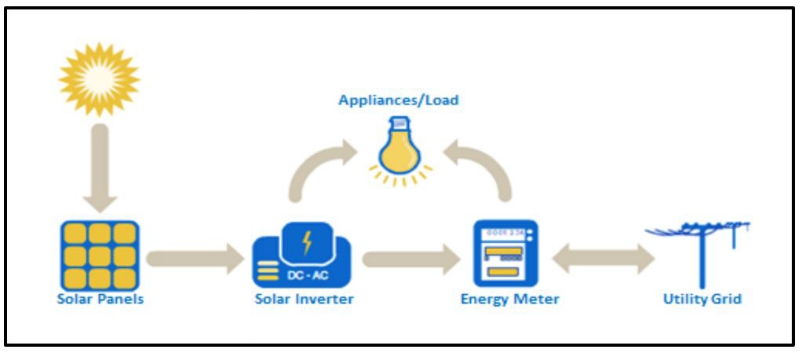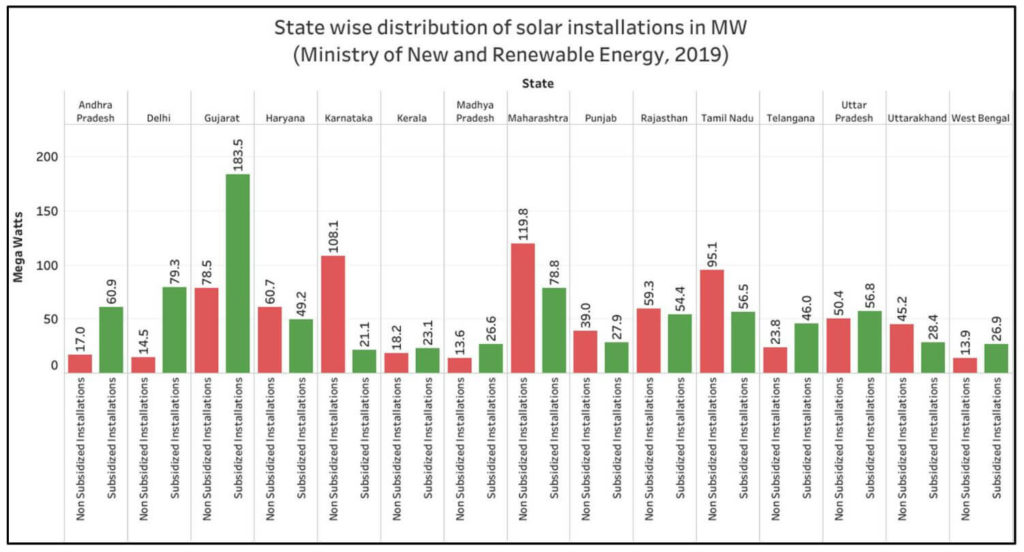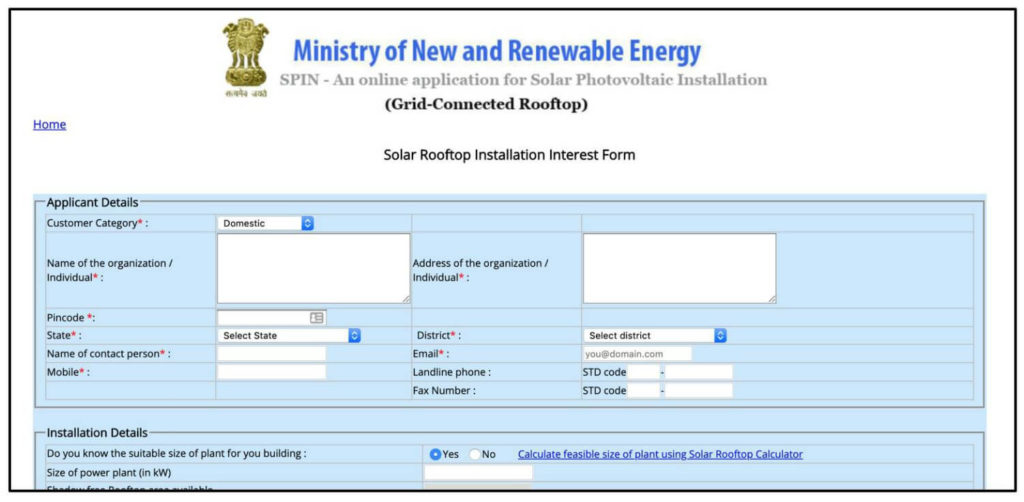[orc]The Government has recently launched Phase-2 of the rooftop solar program with a target to achieve 40,000 MW capacity by 2022. Going by the current pace of installation, this looks highly unlikely.
Solar energy- which is a renewable source of energy- is easily available and has the potential to be highly beneficial to a country like India which is in an ideal geographical location with adequate sunlight. Even though initial set up cost for solar is high, this clean energy has been found out to be less expensive in the long run with operational costs like electricity bills coming down. In remote places where there isn’t any power line or in tough terrains which are yet to be electrified, generating electricity using solar energy will be very helpful for the citizens living there.
In India, a mere 20% of total energy utilisation is from renewable sources. Of this, wind energy constitutes 41%, followed by 31% from solar energy according to a World Bank report released in 2018. In other words, India, despite having sufficient solar energy, has not yet succeeded in making good use of this valuable source. Further, rooftop solar energy contributes only a mere 6% of the total grid connected solar energy being generated.
The National Solar Mission was launched in 2010
In a bid to encourage generation of solar power, the Government of India, in 2010 launched the National Solar Mission (as a part of National Action Plan for Climate Change) aimed at bringing down the cost of generation of solar power in India. The goal was to bring down costs by focussing on long term goals, policy, research & development and domestic production of critical raw materials, components and products by 2022. As a part of this mission, the government also launched the ‘Grid connected Solar Rooftop programme’ to promote the use of this renewable source of energy in households and shops by providing capital subsidy. In this story, the details of this program and the current status are discussed.
What is the Grid connected Solar Rooftop Programme?
Solar rooftop system also known as small SPV (Solar Photo Voltaic) system can be installed in the rooftops of houses, residential or commercial complexes, private institutions, housing societies or government organisations in contrast to the large-scale solar power plants. This can be of two types –
- Solar Rooftop System with storage facility using battery, and
- Grid Connected Solar Rooftop System.

As stated by the Ministry of New and Renewable Energy (MNRE), the average cost of setting up this grid connected rooftop system is Rs. 60 per Watt or Rs. 6 crores per MW peak capacity (1 MW means 1 megawatt and is equal to one million watts) which is pretty expensive and beyond the financial capacity of most Indians. Thus, the Union government as well as State governments- through State Nodal Agencies are providing subsidies to encourage more people to shift to solar.
40% to 70% percent subsidy provided by Central Government
Under the Grid Connected Rooftop Solar Programme, for those who install rooftop solar projects, the Union Government provides Central Financial Assistance (CFA) and incentives. In February 2019, the Government approved the implementation of Phase-2 of the programme. As per the revised norms, the CFA has been raised from 30% in 2014 to 40% in 2019 for general category states. It can go up to 70% in special states (North Eastern states) and UTs. The CFA under residential category will be provided for 4000 MW capacity in Phase-2 of the programme.
The CFA currently is as follows:
- Up to 40% of the benchmark cost for installation of rooftop solar plants (RTS) up to 3kW capacity
- Up to 20% of benchmark cost for plant capacity from 3kWp to 10 kWp for residential sector consumers
- Up to 20% of benchmark cost for Group Housing Societies/Resident welfare Associations (GHS/RWA) for supply of power to common facilities.
- Additional incentives will also be granted to those DISCOMs (Electricity Distribution Companies of India) that achieve additional capacity above the prescribed baseline.
Total of 1700.6 MW of grid connected rooftop systems have been installed across the country
The Ministry has also reported that around 780 MW capacity of rooftop solar plants were installed in the previous two financial years- 2017-18 and 2018-19. The Ministry has also added that an average of 1.5 million units per MW per year is the generation from rooftop plants alone. As on 18 July 2019, total of 1700.54 MW of grid connected rooftop systems have been installed across the country. State wise distribution of 15 states is shown in the following chart.
Gujarat & Maharashtra together account for more than 27% of total RTS capacity

A look into the state wise solar installations reveals that Gujarat has the largest rooftop solar installations in India. The total installation capacity is around 262 MW which accounts for more than 15.4% of the total installation capacity in the country. Maharashtra is second largest with 198.52 MW equivalent to 11.67% of the installation capacity in the country. In Karnataka, Maharashtra, Tamil Nadu and Uttarakhand, the installed capacity of unsubsidized installations is much larger than the capacity of subsidized installations. Of the total 1700.54 MW, 918.42 MW are subsidized installations and the remaining 782.12 MW are unsubsidized installations. In other words, the subsidized installations account for 54% of the total rooftop solar capacity while the unsubsidized ones account for the remaining 46%.
What is the procedure to avail the financial assistance under the scheme?
Eligible beneficiary interested to avail subsidy should directly apply to the implementing agency and get necessary approvals prior to installation of RTS systems. The list of the implementation agencies in various states can be accessed here. One can also express interest on the online interest form. Prior to installation, one should contact the local state nodal agency following which officials will visit the site.
The implementing agency is supposed to select vendors for installation of Rooftop projects by adopting competitive bidding process. Sanction orders are given by MNRE to these implementing agencies for the capacity of the rooftop solar systems planned to be installed by them. The implementing agency must submit complete project details online on the dedicated website for availing eligible service charges and incentives. The online portal captures all details of the project like capacity, project cost, address, district, State, latitude, longitude etc. It has to be noted that MNRE does not sanction any project or subsidy directly to the beneficiaries.

ISRO’s android application to calculate solar potential, elevation and temperatures
The Space Applications Centre of the India Space Research Organisation (ISRO) has developed an application for android operating system which helps in calculating the monthly or annual solar potential and temperatures of the user’s location. This is a very important parameter to finalise the capacity of the SPV systems to be installed. The application also gives details regarding the elevation and day lengths through different times of the year. One can also calculate the feasible size of the plant using the Solar Rooftop calculator available on the dedicated scheme website.
The Government’s 2022 target of 40,000 MW of RTS looks unachievable
By 2022, the Government of India has fixed a target of 40,000 MW worth Rooftop Solar projects to be installed across the country. If implemented successfully, India will be contributing by and large towards ecological sustainability and reduce carbon footprint. In addition to this, the program will also aid in generating employment- up to 9.39 lakh job years for both skilled and unskilled workers to attain the 2022 target. This also supports the Sustainable Development Goal 7 which aims to assure affordable, reliable, sustainable and modern energy for all.
However, the target looks lofty & unachievable as the current cumulative achievement is less than 10% of the 2022 target. If the 2022 target has to be achieved, the current pace of installation of solar rooftop projects has to be increased by 30 times which seems highly unlikely.
Featured Image: Subsidy for Rooftop Solar plants


